Arnold St, Killara
B. 1914 J.E. Dodd, Adelaide. Reb. and enl. 1960 S.T. Noad & Son.
3m., 31 sp. st., 12c., el. pn., Gt: 8.4.2-2/3.2.
Sw: 8.8.8.8.4.4.2.III.16.8.4. Ch: 16.8.8.4.1-1/3.8.4.
Ped: 16.16.16.8.8.8.16.8.4.
Replaced by electronic in early 1990's.
Redundant UK organ res. and installed 2007 Peter Wood & Son of Harrogate UK
1908 Wilkinson of Kendal. Re-built by Church & Co. 1987.
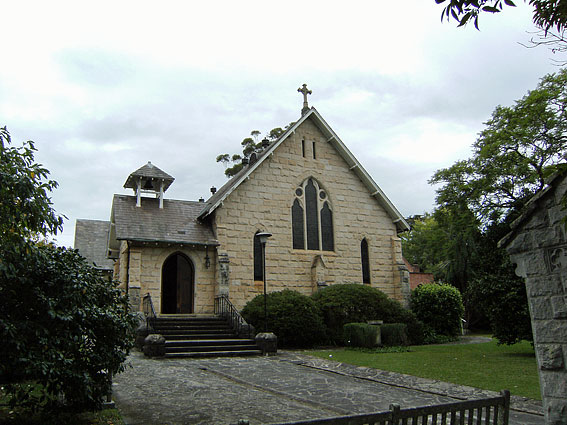

David Alexander (the church's organist) writes in SOJ Winter 2007:
Killara is a suburb of Sydney, NSW, situated on the leafy North Shore, approximately 14 kms from the Sydney GPO. The name "Killara" is aboriginal and means "permanent" or "always there".
Saint Martin's is a traditional Anglican parish of 'broad' churchmanship, and was named after Saint Martin's Church in Salisbury, England. Saint Martin himself was a soldier who was converted to Christianity and founded a monastery at Poitiers, later becoming Bishop of Tours. He died 11 November 401 and was credited with having worked many miracles and seen many visions. The parish was founded on Wednesday, 18 May 1910, when the foundation stone was laid.
The first services were accompanied by a foot-pumped harmonium or American reed organ. This was replaced in 1926 with a small two manual and pedal pipe organ of 12 speaking stops by the well regarded Adelaide builder Josiah Eustace Dodd. This instrument gave good service until 1960, when it was rebuilt and electrified, with less than satisfactory results, by the Sydney builder Sidney Thomas Noad. By the 1980s, this instrument had deteriorated to the point where the wardens of the day, decided to dispose of it. It was sold in 1988 to Saint Alban's Lindfield and rebuilt and enlarged by the Ballina (then Sydney) builder Ian David Brown. The wardens replaced this organ in Saint Martin's with an electronic instrument of English manufacture, at a cost of $65,000.00. At the time, this instrument was state-of-the-art and for 15 years, produced "a very high quality of organ sound". However, by 2002, it had reached the end of its musical life and the manufacturer advised the wardens that total refurbishment was required. The cost of this was approximately $30,000.00.
Given the relatively short, anticipated musical life span of approximately 15 years, of an upgraded instrument, and the minimal guarantee of five years offered, the wardens elected to replace this instrument, hopefully, with a mechanical action pipe organ. Such an instrument was expected to have a life span of up to 100 years, after which it could be restored relatively inexpensively.
Three years were then spent enquiring into the availability of suitable mechanical action, second hand, pipe organs of good provenance. There were a number of possibilities but all cost well in excess of $200,000.00 to acquire, restore, and install and well beyond the resources of the parish which was then engaged in an on-going outreach. But then the two manual and pedal instrument of 18 speaking stops (6 more than the old Dodd organ) in the Methodist Church, Ambleside, in the Lake District, UK, came on to the market. It is appropriate at this stage that I thank Ian Brown for bringing this organ to my attention and to also thank him and other builders for their very considerable assistance to me during the three year search period.
The Ambleside instrument was built in 1908 by the eminent builder, Wilkinson & Son of Kendall, UK, and is of outstanding provenance. Its specification is given below. The Rev David J Crouchley, the Superintendent Minister of Ambleside Methodist Church, writes as follows: "In 1916, five men of the church agreed to 'erect a new organ in the church at a cost of £250'. The organ was built and installed by Wilkinson & Company of Kendall at a final cost of £230. The opening ceremony took place on 5 January 1917. The first organist and choir master was Mr T. B. Atkinson. He continued as organist until 1927, when he wrote recommending Miss Jackson as organist, with himself as deputy. In 1934 the organ was overhauled and cleaned at a cost of £35. In 1987 a similar task cost almost £8,500, the money being raised in five months."
In the opinion of the current restorer, Mr Peter Wood of Harrogate, UK, himself a descendant of a long established firm of organ builders, Wilkinson organs are second only to those built by the greatest English organ builder of the 19th Century, "Father" Henry Willis (Salisbury Cathedral, Truro Cathedral, Saint Paul's London etc). Moreover, as the organ was totally restored in 1987 by the highly regarded builder Nigel Church, with a mechanical action by the German manufacturer Laukhuff, we have been spared the very considerable cost of a complete "makeover". The result is that this instrument comes to us at an "all up" affordable cost of $110,000.00, substantially less than some electronic organs. The specification is ideal for our purposes, including a Great Trumpet stop, so useful for weddings! Moreover, three additional stops are to be added, to increase the versatility of the instrument, namely, a Swell Tremulant, and a Pedal Fagotto/Horn unit.
The restorer has been given a free hand to restore the organ "in a proper and tradesmanlike manner and in accordance with the industry standard for high class work by master organ builders". The works specification is quite specific. Thus, measures will be taken to ensure that the instrument is fully playable in adverse weather conditions and especially, in our hot, dry weather, which is becoming even hotter and drier, with climate change. This is not a museum piece, playable only when the climate is favourable!
From the outset, it was agreed that a Reed rank would be added to the Pedal division, to complement the comprehensive manual specification and support the enthusiastic singing of the congregation. It was hoped to 'clamp' a reed onto the Pedal chest but the pallets were found to be too small, the wind pressure too light, and the headroom too limited. Instead, the reed has been placed on an electro-pneumatic chest, the lowest 12 pipes being newly made by Terry Shires of Shires Organ Pipes Ltd of Leeds, in spotted metal (half length) and with the remaining pipes (full length) coming from a spotted metal T C Lewis Horn rank from an organ formerly in Glasgow.
The oak case and console will be thoroughly restored and finished with a clear lacquer and the façade pipes painted blue with gold leaf applied to the mouths, to match the Saint Martin's logo. Brass candle sconces will be attached to the console, as an eccentric touch, for which I claim full responsibility! We are particularly blessed, that the restorer has located an historic hand carved, solid oak screen from Ripon Parish Church, which will be attached to form the screen to the main aisle.
It is appropriate that I should sound a note of caution to any parish within the Diocese of Sydney, contemplating similar projects. The Diocese claims that any such work costing more than $40,000.00, must be made the subject of an agreement between the Anglican Church Property Trust of the Diocese of Sydney (and not the wardens of the Parish) and the supplier. We wasted twelve months in getting Head Office 'on board' and incurred substantial expenses, including their legal fees. This should be borne in mind.
Throughout, the restorer, Peter Wood, has been a model of efficiency and patience, with a deep love and understanding of his craft. He has had extensive experience in the restoration of old organs and their exportation out of the UK. The organ will be free-standing and placed in the south western Choir Stalls, the Choir singing from the north western Choir stalls. The electronic organ will be retired to the narthex, as a "standby" instrument! We look forward with great anticipation to the completion of the project.
David Alexander writes in SOJ Autumn 2009:
After a three-year search for a good redundant pipe organ a two-manual and pedal instrument of 18 speaking stops from the Methodist Church, Ambleside, in the Lake District, UK, has been installed at St Martin’s.
The Ambleside instrument was built in 1908 by the eminent builder, Wilkinson & Son of Kendall, UK, and is of outstanding provenance. Its specification is given below. The organ was built and installed by Wilkinson at a final cost of £250. In 1934 the organ was overhauled and cleaned, when the original tracker action was replaced with a pneumatic action. In 1987 a similar task cost almost £8,500, when the pneumatics were returned to tracker!
In the opinion of the current restorer, Mr Peter Wood of Harrogate, UK, himself a descendant of a long established firm of organ builders, Wilkinson organs are second only to those built by the greatest English organ builder of the 19th Century, “Father” Henry Willis. Moreover, as the organ was totally restored in 1987 by the highly regarded builder Nigel Church, with a mechanical action by the German manufacturer Laukhuff, the church has been spared the very considerable cost of a complete “makeover”. The result is that this instrument comes at an “all up” affordable cost of $100,000, substantially less than some electronic organs. The specification is ideal for our purposes, including a Great Trumpet stop, so useful for weddings! Moreover, three additional stops were added, to increase the versatility of the instrument, namely, a Swell Tremulant, and a Pedal Fagotto/Horn unit. The instrument responds well to a wide-ranging repertoire.
The restorer has been given a free hand to restore the organ “in a proper and tradesmanlike manner and in accordance with the industry standard for high class work by master organ builders”. The works specification is quite specific. Thus, measures were taken to ensure that the instrument is fully playable in adverse weather conditions and, especially, in hot, dry weather, which is expected to become even hotter and drier, with climate change.
From the outset, it was agreed that a reed rank would be added to the Pedal Division, to complement the comprehensive manual specification and support the enthusiastic singing of the congregation. It was hoped to ‘clamp’ a reed onto the Pedal chest but the pallets were found to be too small, the wind pressure too light, and the headroom too limited. Instead, the reed has been placed on an electro-pneumatic chest, the lowest 12 pipes being newly made by Terry Shires of Shires Organ Pipes Ltd of Leeds, in spotted metal (half length) and with the remaining pipes (full length) coming from a spotted metal T C Lewis Horn rank from an organ formerly in Glasgow.
The façade pipes were painted blue with gold leaf applied to the mouths, to match the Saint Martin’s logo. Brass candle sconces were attached to the console, for use on special occasions! An historic, hand carved, solid oak screen from Ripon Parish Church, has been attached to form the screen to the main aisle.
Future work will involve enclosing the sides of the organ, hopefully in timber, to prevent the escape of lateral sound, and reconstruction of the couplers, which at present are unreliable. A concave and radiating pedal board of 30 notes is, however, a “pipe dream” for now!
David Alexander
SPECIFICATION OF THE WILKINSON OF KENDAL ORGAN - 1908. Re-built by Church & Co. 1987. To be restored and installed in Saint Martin's Killara NSW by Peter Wood & Son of Harrogate UK. Mechanical action throughout, except for the Pedal Fagotto/Horn unit, on electro-pneumatic action.
| Great Open Diapason Stopped Diapason Dulciana Principal Twelfth Fifteenth Mixture Trumpet Swell (enclosed) Open Diapason Gedacht Salicional Gemshorn Fifteenth Cornopean Oboe Tremulant Pedal Bourdon Bass Flute Fagotto Horn Couplers Swell to Great Swell to Pedal Great to Pedal |
8 8 8 4 2-2/3 2 II 8 8 8 8 4 2 8 8 16 8 16 8 |
(1) (2) (3) (4) |
Compass 56/29
3 Composition Pedals to Great
2 Composition Pedals to Swell
1 Reversible piston (Pedal reed) (5)
Centrally positioned balanced Swell Pedal
BOB Organ Blower
NOTES:
(1) New 2007.
(2) New Nigel Church 1987, 41 note unit 16/8, mechanical action.
(3) New 2007, 42 note unit 16/8, electro-pneumatic action.
(4) Spotted metal T C Lewis pipes from Glasgow organ.
(5) New 2007.
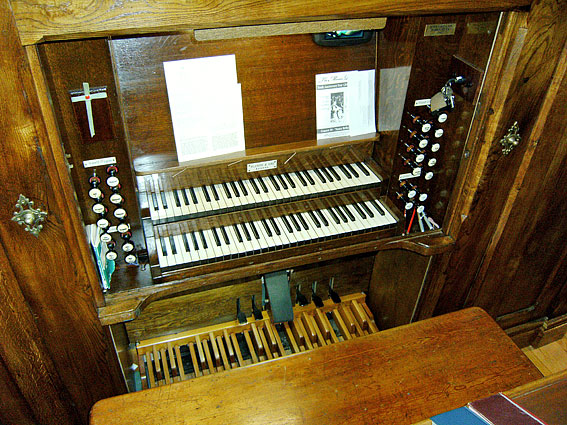
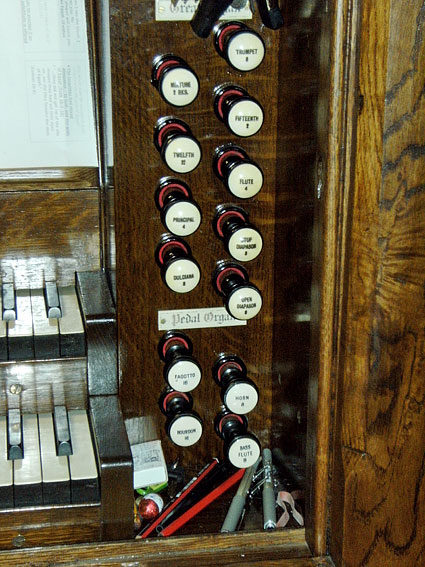
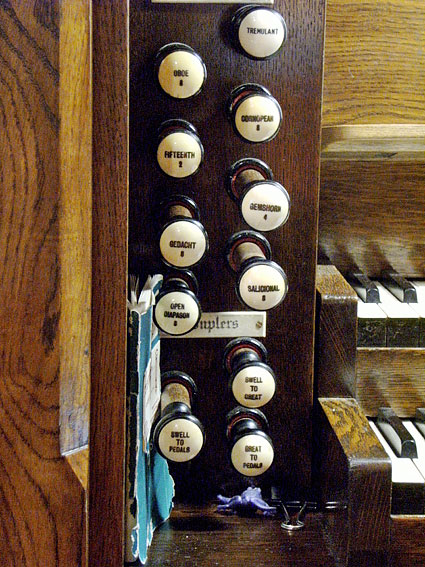
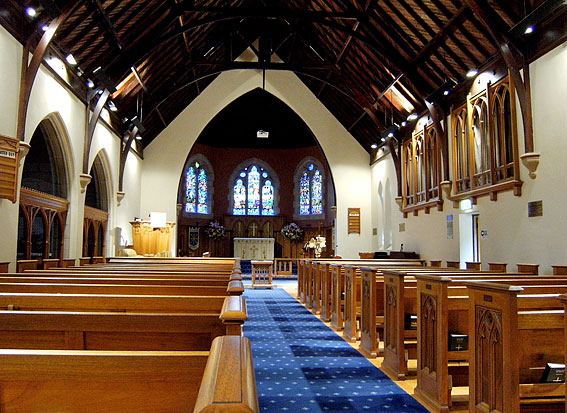
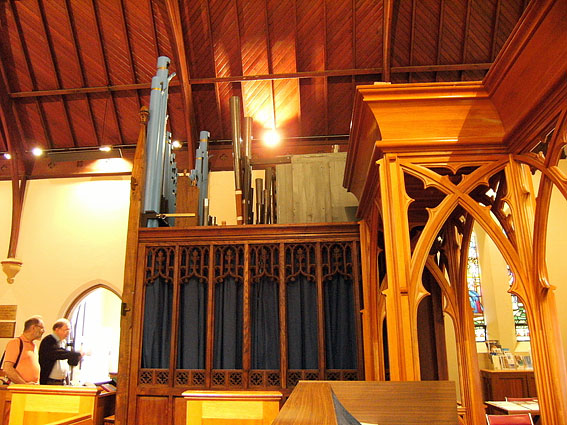
Photos: Mark Quarmby (April 2009)